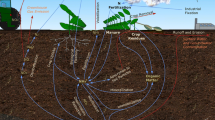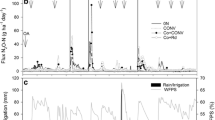Abstract
To investigate the fate of urea nitrogen (N) applied to vegetable fields, three N rates, N0 (0 kg N/ha), N1(225 or 240 kg N/ha) and N2 (450 or 480 kg N/ha) were applied to a rotation system. Nitrogen fertilizer recovery (NFR), N residue in soil, and N losses were measured in situ. Higher N application rates resulted in lower NFR, and increased N residues in soil and losses. The NFR, Chinese cabbage, and eggplant were different in the N1 and N2 groups (P < 0.01). The ratios of N fertilizer residue at 0–60 cm deep ranged from 30.2 to 41.1 % (N1), and 33.1 to 57.7 % (N2). The N loss ratios were only 6.6 % (N1) and 11.9 % (N2), because of the lower precipitation rates and temperatures characteristic of its growing season; meanwhile, N losses were 31.1 and 37.4 % in cayenne pepper, and 24.1 and 29.2 % in eggplants in the N1 and N2 treatments, respectively. The main pathways of N loss were leaching, followed by gaseous losses; these were major pathways of N loss in seasons with lower precipitation rates. NH3 volatilization was correlated with soil temperature (P < 0.01), and N2O emissions were correlated with soil moisture in the N1 treatment and with soil NH4 +-N concentration in the N2 treatment (P < 0.01). Denitrification rates were correlated with soil moisture in the N0 and N1 treatments, and with NO3 −-N content in the N2 treatment (P < 0.01). Finally, loss due to runoff was correlated with precipitation (P < 0.01).





Similar content being viewed by others
References
Abras M, Goffart JP, Renard S, Destain JP (2012) Management of nitrogen fertilization of fresh vegetable crops at field scale in the walloon region of Belgium. Acta Hortic 938:235–242
Alberts EE, Schuman GE, Burwell RE (1978) Seasonal runoff losses of nitrogen and phosphorus from Missouri valley loess watersheds. J Environ Qual 7:203–208
Babiker IS, Mohamed MA, Terao H, Kato K, Ohta K (2004) Assessment of groundwater contamination by nitrate leaching from intensive vegetable cultivation using geographical information system. Environ Int 29:1009–1017
Baligar VC, Fageria NK, He ZL (2001) Nutrient use efficiency in plants. Commun Soil Sci Plant Anal 32:921–950
Barrclough D, Hyden MJ, Davies GP (1983) Fate of N fertilizeritrogen applied to grassland. I. Field leaching results. Eur J Soil Sci 34:483–497
Cai GX, Chen DL, Ding H, Pacholski A, Fan XH, Zhu ZL (2002) Nitrogen losses from fertilizers applied to maize, wheat and rice in the North China Plain. Nutr Cycl Agroecosyst 63:187–195
Cao B, He FY, Xu QM, Cai GX (2007) Nitrogen use efficiency and N losses in Chinese cabbage cultivation in an open field. Plant Nutr Fertil Sci 13:1116–1122 (in Chinese with English summary)
Cui Z, Chen X, Zhang F (2010) Current nitrogen management status and measures to improve the intensive wheat–maize system in China. Ambio 39:376–384
Cui S, Shi Y, Groffman PM, Schlesinger WH, Zhu YG (2012) Centennial-scale analysis of the creation and fate of reactive nitrogen in China (1910–2010). Proc Natl Acad Sci USA 110:2052–2057
Destain JP, Francois E, Guiot J, Goffart JP, Vandergeten JP, Bodson B (1993) Fate of nitrogen fertilizer applied on two main arables crops, winter wheat (Triticum aestivum) and sugar beet (Beta vulgaris) in the loam region of Belgium. Plant Soil 155–156:367–370
Di HJ, Cameron KC, Podolyan A, Robinson A (2014) Effect of soil moisture status and a nitrification inhibitor, dicyandiamide, on ammonia oxidizer and denitrifier growth and nitrous oxide emissions in a grassland soil. Soil Biol Biochem 73:59–68
Ding H, Wang YS, Xiang HY, Li WH (2004) Denitrification loss and N2O emission from nitrogen fertilizer applied to vegetable field. Acta Hortic Sin 31:762–766 (in Chinese with English summary)
Elliot JR, Fox TR (2014) Ammonia volatilization following fertilization with urea or ureaform in a thinned loblolly pine plantation. Soil Sci Soc Am J 78:1469–1473
Fan ZB, Lin S, Zhang XM, Jiang ZM, Yang KC, Jian DD, Chen YZ, Li JL, Chen Q, Wang JG (2014) Conventional flooding irrigation causes an overuse of nitrogen fertilizer and low nitrogen use efficiency in intensively used solar greenhouse vegetable production. Agric Water Manag 144:11–19
Galloway JN, Townsend AR, Erisman JW, Bekunda M, Cai Z, Freney JR, Martinelli LA, Seitzinger SP, Sutton MA (2008) Transformation of the nitrogen cycle: recent trends, questions, and potential solutions. Science 320:889–892
Hirel B, Tétu T, Lea PJ, Dubois F (2011) Improving nitrogen use efficiency in crops for sustainable agriculture. Sustainability 3:1452–1485
Hoben JP, Gehl RJ, Millar N, Grace PR, Robertson GP (2011) Nonlinear nitrous oxide (N2O) response to nitrogen fertilizer in on-farm corn crops of the US Midwest. Global Change Biol 17:1140–1152
Ji XH, Zheng SX, Lu YH, Liao YL (2007) Study of dynamics of floodwater nitrogen and regulation of its runoff loss in paddy field-based two-cropping rice with urea and controlled release nitrogen fertilizer application. Chin J Appl Ecol 18:1432–1440 (in Chinese with English summary)
Kleinman PJA, Srinivasan MS, Dell CJ, Schmidt JP, Sharpley AN, Bryant RB (2006) Role of rainfall intensity and hydrology in nutrient transport via surface runoff. J Environ Qual 35:1248–1259
Min J, Zhao X, Shi WM, Xing GX, Zhu ZL (2011) Nitrogen balance and loss in a greenhouse vegetable system in southeastern China. Pedosphere 21:464–472
Min J, Zhang HL, Shi WM (2012) Optimizing nitrogen input to reduce nitrate leaching loss in greenhouse vegetable production. Agric Water Manage 111:53–59
Ministry of Agriculture of China (2008) China’s vegetable production and cultivated area ranks first in the world. Chin Veg 12:70 (in Chinese)
Pang XB, Mu YJ, Lee XQ, Fang SX, Yuan J, Huang DK (2009) Nitric oxides and nitrous oxide fluxes from typical vegetables cropland in China: effects of canopy, soil properties and field management. Atmos Environ 43:2571–2578
Predotova M, Bischoff WA, Buerkert A (2011) Mineral-nitrogen and phosphorus leaching from vegetable gardens in Niamey, Niger. J Plant Nutr Soil Sci 174(1):47–55
Raun WR, Johnson GV (1999) Improving nitrogen use efficiency for cereal production. Agron J 91:357–363
Ryden JC, Lund LJ, Letey J, Focht DD (1979) Direct measurement of denitrification loss from soils: II. Development and application of field methods. Soil Sci Soc Am J 43:110–118
Schlesinger WH (2009) On the fate of anthropogenic nitrogen. Proc Natl Acad Sci USA 106:203–208
Song XZ, Zhao CX, Wang XL, Li J (2009) Study of nitrate leaching and nitrogen fate under intensive vegetable production pattern in northern China. CR Biol 332:385–392
Stevens WB, Hoeft RG, Mulvaney RL (2005) Fate of nitrogen-15 in a long-term nitrogen rate study. Agron J 97:1046–1053
Tian YH, Yin B, Yang LZ, Yin SX, Zhu ZL (2007) Nitrogen runoff and leaching losses during rice-wheat rotations in Taihu lake region, China. Pedosphere 17:445–456
Velthof GL, Oudendag D, Witzke HP, Asman WAH, Klimont Z, Oenema O (2009) Integrated assessment of nitrogen losses from agriculture in EU-27 using MITERRA-EUROPE. J Environ Qual 38:402–417
Wang ZH, Liu XJ, Ju XT, Zhang FS, Malhi S (2004) Ammonia volatilization loss from surface-broadcast urea: comparison of vented-and closed-chamber methods and loss in winter wheat-summer maize rotation in North China Plain. Commun Soil Sci Plant Anal 35:2917–2939
Wang JY, Xiong ZQ, Yan XY (2011) Fertilizer-induced emission factors and background emissions of N2O from vegetable fields in China. Atmos Environ 45:6923–6929
Widowati LR, Neve SD, Sukristiyonubowo Setyorini D, Kasno A, Sipahutar IA (2011) Nitrogen balances and nitrogen use efficiency of intensive vegetable rotations in South East Asian tropical Andisols. Nutr Cycl Agroecosyst 91:131–143
Xiong ZQ, Xie YX, Xing GX, Zhu ZL, Butenhoff C (2006) Measurements of nitrous oxide emissions from vegetable production in China. Atmospheric Environ 40:2225–2234
Yan X, Jin JY, He P, Liang MZ (2008) Recent advances in technology of increasing fertilizer use efficiency. Sci Agric Sin 41:450–459
Zhang GS, Li JC, Hu XB, Zhang XX (2013) On-farm assessment of soil erosion and non-point source pollution in a rain-fed vegetable production system at Dianchi lake’s catchment, southwestern China. Nutr Cycl Agroecosyst 96:67–77
Zhao X, Xie YX, Xiong ZQ, Yan XY, Xing GX, Zhu ZL (2009) Nitrogen fate and environmental consequence in paddy soil under rice-wheat rotation in the Taihu lake region, China. Plant Soil 319:225–234
Zhao CS, Hu CX, Huang W, Sun XC, Tan QL, Di HJ (2010) A lysimeter study of nitrate leaching and optimum nitrogen application rates for intensively irrigated vegetable production systems in Central China. J Soils Sediments 10(1):9–17
Zhu ZL, Chen DL (2002) Nitrogen fertilizer use in China—contributions to food production, impacts on the environment and best management strategies. Nutr Cycl Agroecosyst 63:117–127
Zhu JH, Li XL, Christie P, Li JL (2005) Environmental implications of low nitrogen use efficiency in excessively fertilized hot pepper (Capsicum frutescens L.) cropping systems. Agric Ecosyst Environ 111:70–80
Acknowledgments
This work was supported by grants from the National Natural Science Foundation of China (Grant No. 31270556, 41401339), the State Key Laboratory of Soil Erosion, and Dryland Farming on Loess Plateau, China (Grant No. 10501-291) and Fujian Provincial Natural Science Foundation (Grant No. 2006J0009).
Author information
Authors and Affiliations
Corresponding author
Ethics declarations
Conflict of interest
All authors have no conflicts of interest regarding this paper.
Rights and permissions
About this article
Cite this article
Ding, H., Li, S., Zhang, Y. et al. The fate of urea nitrogen applied to a vegetable crop rotation system. Nutr Cycl Agroecosyst 103, 279–292 (2015). https://doi.org/10.1007/s10705-015-9738-x
Received:
Accepted:
Published:
Issue Date:
DOI: https://doi.org/10.1007/s10705-015-9738-x




